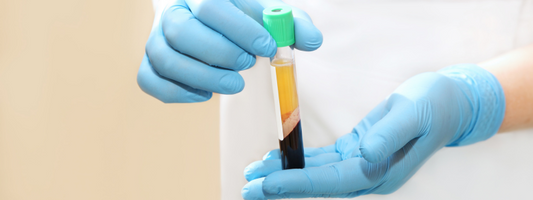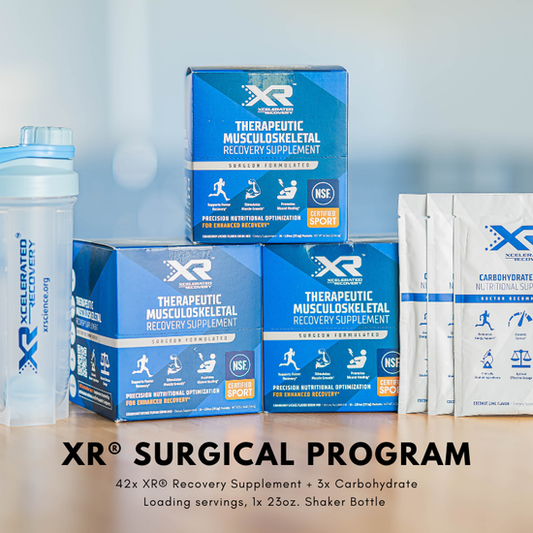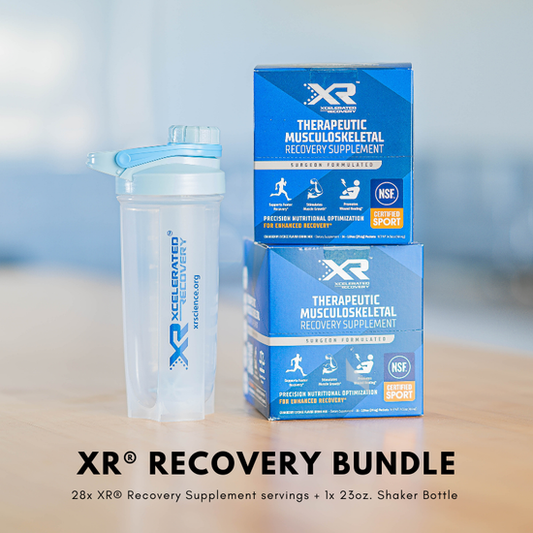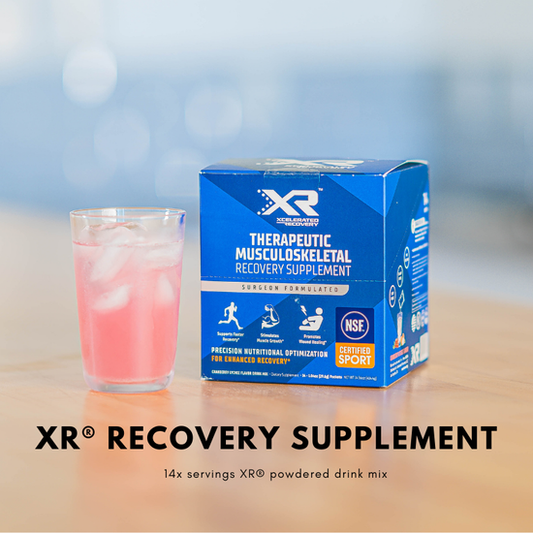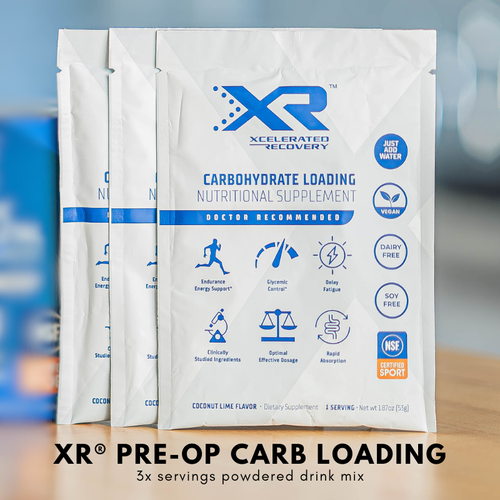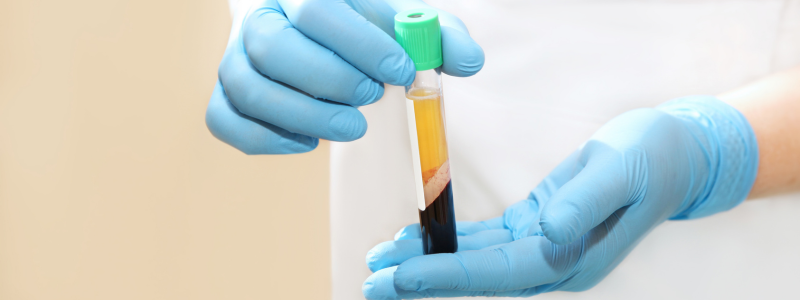
How to Get the Most Out of Your PRP Treatment: Optimizing Your Biology in the Era of Regenerative Medicine
Share
Author: The XR® Team
In the evolving field of regenerative medicine, treatments like Platelet-Rich Plasma (PRP) and Bone Marrow Aspirate are revolutionizing how we harness the body’s natural ability to heal. These therapies rely not on drugs or foreign substances, but on the patient’s own biologic material, making the quality of that material paramount. Yet, one often overlooked factor is this: the efficacy of your PRP treatment is only as strong as the tissue you harvest.
If you're investing in orthobiologic procedures like PRP, it's time to consider a powerful concept, priming your body beforehand to optimize your results. This blog breaks down the science-backed strategies you can use to improve your platelet yield, growth factor profile, and overall healing potential.
Why Your “Baseline Biology” Matters in PRP
PRP works by concentrating your platelets, biologically active blood components that release healing proteins known as growth factors. But the potency of PRP is not uniform. It can vary significantly based on individual factors such as lifestyle, nutrition, and underlying metabolic conditions.
That’s where optimization strategies come in. By tweaking your routine just days or hours before a PRP draw, you can increase the quantity and quality of what's harvested.
-
Exercise: Boost Platelet and Stem Cell Counts Naturally A compelling 2019 study published in Arthroscopy found that just 20 minutes of vigorous cycling (at 70–85% of your target heart rate) significantly enhanced the quality of PRP:
- Platelet counts in whole blood increased by 22% after exercise.
- Buffy coat PRP showed increases in hematopoietic progenitor cells (HPCs) (from 1.7/mL to 2.7/mL, p = .043), key contributors to tissue regeneration.
- Both plasma-based and buffy-coat PRP systems produced higher concentrations and volume of platelets post-exercise.
Takeaway: Engage in a short burst of intense aerobic exercise 1–2 hours before your PRP appointment to boost stem cell and platelet availability. Discuss this with your provider to ensure it’s appropriate for your medical condition.
-
Branched-Chain Amino Acids (BCAAs): Fuel for Platelet Production Branched-chain amino acids—leucine, isoleucine, and valine—are more than just supplements for athletes. Research shows they promote thrombocytopoiesis (platelet production) by activating the mTOR signaling pathway, which regulates cell growth and differentiation.
In a 2023 study, BCAA-fed mice showed significant increases in megakaryocyte activity, the bone marrow cells responsible for making platelets. This led to higher reticulated (young, active) platelet counts and faster regeneration after depletion.
Another study from Circulation showed that oral ingestion of BCAAs in humans:
- Enhanced platelet aggregation responses within 1 hour of intake, peaking around 90–120 minutes post-ingestion.
- Boosted platelet activation via the integrin αIIbβ3 signaling pathway, essential for clot formation and tissue repair.
Takeaway: Consider taking a balanced BCAA supplement (at a 2:1:1 leucine:isoleucine:valine ratio) 1.5–2 hours before your PRP draw. This timing aligns with peak platelet activation observed in research. As always, consult your physician before starting any supplement regimen.

Nutritional and Metabolic Readiness
While the papers primarily focus on BCAAs and exercise, the broader implication is clear: your metabolic state directly influences your PRP’s regenerative quality.
Additional supportive actions might include:
- Hydration: Ensures optimal blood volume and cell separation during centrifugation.
- Anti-inflammatory diet: Helps reduce baseline systemic inflammation, allowing growth factors to work more efficiently.
- Avoiding NSAIDs and alcohol before your PRP draw, as both can negatively affect platelet function.
Prime Your Body, Maximize Your Outcomes
As orthobiologic treatments continue to gain ground, the concept of patient optimization before biologic harvest is becoming essential. Think of it as preconditioning your body—just like you would warm up before a workout, you’re preparing your biology for peak performance.
Key Action Items: 🚴 20 minutes of high-intensity aerobic exercise 1–2 hours before your blood draw.
- 💊 Take BCAAs / XR 90–120 minutes before treatment (if cleared by your provider).
- 🥦 Eat clean, hydrate well, and avoid NSAIDs or alcohol in the 48 hours leading up to treatment.
By taking a proactive role, you can truly get the most out of your PRP, amplifying its regenerative potential and accelerating your recovery.
⚠️ What to Avoid Before Your PRP Procedure
While enhancing platelet activation is key to a potent PRP sample, some foods and supplements can suppress platelet function or interfere with clot formation, reducing the regenerative potential of your treatment.
Here are commonly consumed substances to avoid 3–5 days before your procedure (unless directed otherwise by your physician):
❌ Fish Oil (Omega-3 Fatty Acids) Effect: Inhibits platelet aggregation and prolongs bleeding time.
- Why Avoid: May reduce the concentration or function of growth-factor–rich platelets in PRP.
- Common Sources: Fish oil capsules, flaxseed oil, high-dose EPA/DHA.
❌ Ginseng Effect: Antiplatelet and anticoagulant activity through nitric oxide pathways.
- Why Avoid: May diminish the pro-healing response expected from PRP.
❌ Garlic (high doses) Effect: Contains allicin, which inhibits platelet aggregation.
- Why Avoid: Large quantities or supplements can increase bleeding risk and alter platelet function.
❌ Turmeric / Curcumin Effect: Acts as a natural COX inhibitor and can reduce platelet aggregation.
- Why Avoid: While anti-inflammatory, it may counteract desired platelet activity at the site of healing.
❌ NSAIDs (e.g., Ibuprofen, Aspirin, Naproxen) Effect: Strong inhibitors of cyclooxygenase (COX-1), which impairs thromboxane A2 production and platelet activation.
- Why Avoid: PRP relies on the full activity of platelets to release growth factors. NSAIDs blunt this response.
❌ Vitamin E (high doses) Effect: Anticoagulant properties; inhibits platelet aggregation.
- Why Avoid: High doses may lead to bleeding complications and reduce platelet yield in PRP.
❌ Alcohol Effect: Reduces platelet count and function, increases vascular permeability.
- Why Avoid: Even moderate intake within 48 hours can affect the quality of your blood draw.

✅ What to Do Instead: Replace fish oil with foods rich in omega-9 fatty acids (e.g., olive oil, avocado).
- Use anti-inflammatory foods that don’t suppress platelets—like berries, leafy greens, and cruciferous vegetables.
- Stay well hydrated and maintain a stable, clean diet with high-quality protein and complex carbohydrates in the days leading up to your procedure.
Recap:
Your Pre-PRP Checklist Action > Timing
20 mins of aerobic exercise
- 1–2 hrs before draw
XR/ BCAA supplementation (2:1:1 ratio)
- 90–120 mins prior
Hydration & clean diet
- 2–3 days prior
Stop NSAIDs & alcohol
- At least 48 hrs prior
Stop platelet-inhibiting supplements
- 3–5 days prior
Final Thought: Regenerative medicine isn't passive. By actively priming your body, you not only get better-quality PRP, you set the stage for faster healing and more predictable results.
References:
- Xu Y, Jiang H, Li L, et al. Branched-chain amino acid catabolism promotes thrombosis risk by enhancing tropomodulin-3 propionylation in platelets. Circulation. 2020;142(1):49-64. doi:10.1161/CIRCULATIONAHA.119.043581.
- Anz AW, Parsa RS, Romero-Creel MF, Nabors A, Tucker MS, Harrison RM, Matuska AM. Exercise-Mobilized Platelet-Rich Plasma: Short-Term Exercise Increases Stem Cell and Platelet Concentrations in Platelet-Rich Plasma. Arthroscopy. 2019 Jan;35(1):192-200. doi: 10.1016/j.arthro.2018.06.043. PMID: 30611351.
- Jiang, H., Xu, Y., Li, L., Liu, Y., Zhou, M., Wang, J., Jiang, J., Fan, X., Yan, H., Yu, Z., Wang, Q., Gong, Y., Li, X., & Li, X. (2023). Branched-chain amino acids promote thrombocytopoiesis. iScience, 26(11), 108283. https://doi.org/10.1016/j.isci.2023.108283







